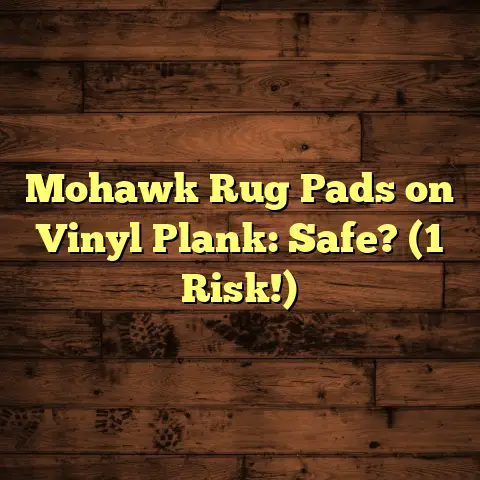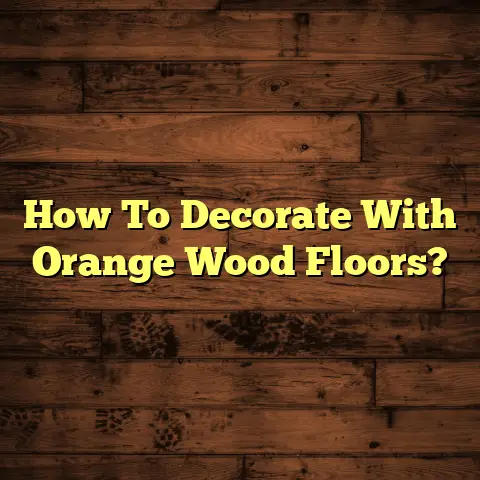Clean LVP Like A Pro: Step-by-Step! (5 Tips)
Flooring has come a long way, hasn’t it?
I remember when hardwood and stone were the only real options.
Think back to ancient Roman villas with their intricate mosaic floors.
Or the grand halls of medieval castles featuring solid oak planks.
These materials were beautiful, sure, but also incredibly expensive and demanding to maintain.
Fast forward to the late 20th century, and suddenly, Luxury Vinyl Plank (LVP) bursts onto the scene.
It mimics the look of real wood or stone but is way more affordable, durable, and, let’s be honest, easier to live with.
By the early 2000s, LVP was everywhere, from bustling commercial spaces to cozy homes like yours and mine.
But here’s the thing: even though LVP is tough, it still needs the right care to look its best and last for years.
That’s why I’m here to share my pro tips on cleaning LVP like a seasoned flooring contractor.
Section 1: Understanding Luxury Vinyl Plank (LVP)
So, what exactly is LVP?
Well, it’s a multi-layered synthetic flooring product designed to replicate the look of natural materials.
Typically, it consists of:
- A wear layer: This is the top, protective layer that resists scratches, stains, and fading.
- A decorative layer: This is where the magic happens – a high- resolution printed image that gives LVP its realistic wood or stone appearance.
- A core layer: This provides the plank with its rigidity and stability, often made from PVC or other composite materials.
- An underlayment (sometimes): Some LVP comes with an attached underlayment for added comfort and sound insulation.
The Benefits?
Oh, where do I start?
- Water Resistance: HUGE plus. LVP laughs in the face of spills and moisture, making it perfect for kitchens, bathrooms, and mudrooms.
- Durability: It can handle heavy foot traffic, kids, pets – you name it.
- Ease of Installation: Many LVP options are designed for DIY installation, saving you money on professional labor.
- Affordability: Compared to hardwood or stone, LVP is a budget- friendly option that doesn’t compromise on style.
Finishes and Styles Galore:
The market is flooded with options!
You’ll find LVP that mimics everything from rustic reclaimed wood to sleek marble.
Embossed textures, varying plank widths, and different gloss levels allow you to customize your floor to perfectly match your aesthetic.
Section 2: Importance of Cleaning and Maintenance
Listen, I get it. Cleaning isn’t exactly anyone’s favorite pastime.
But with LVP, a little effort goes a long way.
Why is regular cleaning so crucial?
- Preventing Scratches: Dirt and grit act like sandpaper under your feet, slowly scratching the wear layer.
- Avoiding Stains: Spills left unattended can seep into the surface and cause discoloration.
- Eliminating Buildup: Over time, cleaning product residue, grime, and oils can create a dull, sticky film on your floor.
What happens if you neglect cleaning?
- Decreased Lifespan: Scratches and stains can compromise the protective wear layer, leading to premature wear and tear.
- Reduced Aesthetic Appeal: A dirty, dull floor simply doesn’t look as good. It can make your entire home feel less inviting.
- Increased Risk of Damage: Neglecting spills can lead to moisture damage, even with water-resistant LVP.
I’ve seen floors that were practically brand new ruined because the homeowners skipped regular cleaning.
Don’t let that happen to you!
Section 3: Step-by-Step Cleaning Guide
Alright, let’s get down to the nitty-gritty.
Here’s my tried-and-true method for cleaning LVP like a pro.
Tip 1: Gather the Right Supplies
Having the right tools makes all the difference.
Here’s what you’ll need:
- Broom: A soft-bristled broom for sweeping up loose debris.
- Vacuum: A vacuum cleaner with a hard floor attachment (no beater bar!).
- Mop: A microfiber mop is my personal favorite. It’s gentle, effective, and easy to clean.
- Cleaning Solution: This is crucial!
- pH-Neutral Cleaner: Look for cleaners specifically designed for LVP or resilient flooring. These are formulated to be gentle and won’t damage the finish.
- DIY Option: A mixture of water and a small amount of dish soap (like Dawn) can work in a pinch, but be sure to rinse thoroughly.
- Microfiber Cloths: For spot cleaning and drying.
- Spray Bottle (Optional): For applying cleaning solution.
- Two Buckets: One for clean water and one for rinsing your mop.
Why Non-Abrasive and pH-Neutral?
Abrasive cleaners can scratch the wear layer, dulling the finish.
Acidic or alkaline cleaners can damage the LVP over time, causing discoloration or even warping.
I always tell my clients: when in doubt, go gentle!
Tip 2: Regular Sweeping and Vacuuming
This is your first line of defense against dirt and scratches.
- Frequency: Aim to sweep or vacuum your LVP floor at least twice a week, or more often in high-traffic areas.
- Technique:
- Sweeping: Use a soft-bristled broom to sweep up loose dirt, dust, and debris. Pay attention to corners and edges.
- Vacuuming: Use a vacuum cleaner with a hard floor attachment. Important: Disable the beater bar! The rotating brush can scratch the LVP surface.
- Focus on High-Traffic Areas: Entryways, hallways, and kitchens tend to accumulate the most dirt.
I’ve seen homeowners who vacuum their LVP daily, and their floors look amazing for years. It’s all about prevention!
Tip 3: Mopping Techniques for Deep Clean
Mopping is essential for removing stubborn dirt and grime.
- Frequency: How often you mop depends on your lifestyle.
- Low-Traffic Homes: Once every 1-2 weeks.
- High-Traffic Homes with Kids and Pets: Once a week, or even more often.
- Preparation:
- Sweep or Vacuum First: Always remove loose dirt and debris before mopping.
- Prepare Your Cleaning Solution: Follow the manufacturer’s instructions for your chosen cleaner. If using a DIY solution, mix a small amount of dish soap with warm water.
- Mopping Steps:
- Dip Your Mop: Dip your microfiber mop into the bucket of cleaning solution and wring out the excess water. The mop should be damp, not soaking wet.
- Mop in Sections: Work in small sections, overlapping each stroke slightly.
- Rinse Your Mop: Rinse your mop in the second bucket of clean water after each section. This prevents you from spreading dirty water around.
- Dry the Floor (Optional): If you want to speed up the drying process, you can use a clean, dry microfiber cloth to wipe up any excess water.
My Go-To Mop:
I swear by microfiber mops.
They’re gentle on LVP, pick up dirt effectively, and are easy to wash.
Plus, they don’t leave behind streaks like some traditional mops.
Tip 4: Spot Cleaning Stains and Spills
Accidents happen. The key is to act fast!
- Immediate Action: The sooner you address a spill, the less likely it is to stain.
- Blot, Don’t Rub: Use a clean microfiber cloth to blot up the spill. Rubbing can spread the stain and damage the surface.
- Common Stain Solutions:
- Food Stains: Warm water and dish soap usually do the trick.
- Pet Accidents: Use an enzymatic cleaner specifically designed for pet stains. These cleaners break down the enzymes in urine and feces, eliminating odors and preventing staining.
- Grease: Sprinkle baking soda on the stain to absorb the grease, then vacuum it up and clean with warm water and dish soap.
- Ink: Try rubbing alcohol on a cotton swab, gently blotting the stain.
- Tough Stains: For stubborn stains, you can try a slightly stronger cleaner, but always test it in an inconspicuous area first to make sure it doesn’t damage the LVP.
I once had a client whose dog had an “accident” on their brand-new LVP floor.
They panicked and started scrubbing with a harsh cleaner, which ended up damaging the finish.
I was able to salvage the situation, but it was a good reminder that gentle is always better!
Tip 5: Long-Term Maintenance and Care
Cleaning is just one part of the equation.
Here’s how to keep your LVP looking its best for years to come:
- Use Floor Protectors: Place felt pads under the legs of furniture to prevent scratches.
- Area Rugs: Use area rugs in high-traffic areas to protect the LVP from wear and tear.
- Doormats: Place doormats at entrances to trap dirt and debris before they get tracked onto the floor.
- Avoid Harsh Chemicals: Never use abrasive cleaners, scouring pads, or harsh chemicals on LVP.
- Control Humidity: Excessive humidity can cause LVP to expand and contract, leading to warping. Use a dehumidifier in damp areas.
Professional Cleaning?
While LVP is relatively low-maintenance, you may want to consider professional cleaning every few years.
Professional cleaners have specialized equipment and solutions that can remove stubborn dirt and grime without damaging the floor.
Refinishing LVP:
Unlike hardwood, LVP cannot be sanded and refinished.
However, if your LVP is severely damaged, you can often replace individual planks without having to replace the entire floor.
Conclusion: Recap and Final Thoughts
So, there you have it – my expert tips for cleaning LVP like a pro.
Remember:
- Regular cleaning is key to preventing scratches, stains, and buildup.
- Use the right supplies, including a pH-neutral cleaner and a microfiber mop.
- Act fast when spills occur.
- Take preventative measures to protect your LVP from wear and tear.
By following these simple tips, you can keep your LVP floor looking stunning for years to come.
Trust me, a little effort goes a long way.
LVP is a fantastic flooring option that offers both beauty and durability.
With the right care, it’s a wise investment that will enhance the look and value of your home.
Now, go forth and clean with confidence!





